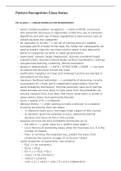Samenvatting
Patter Recognition Summary & Course Notes
- Instelling
- Universiteit Utrecht (UU)
This document contains notes and summaries covering the content of the course Pattern Recognition within the Artificial Intelligence Master at Utrecht University. It covers the following topics: - LMs for regression - LMs for classification 1&2 - intro to DL and NN - CNNs - RNNs
[Meer zien]




